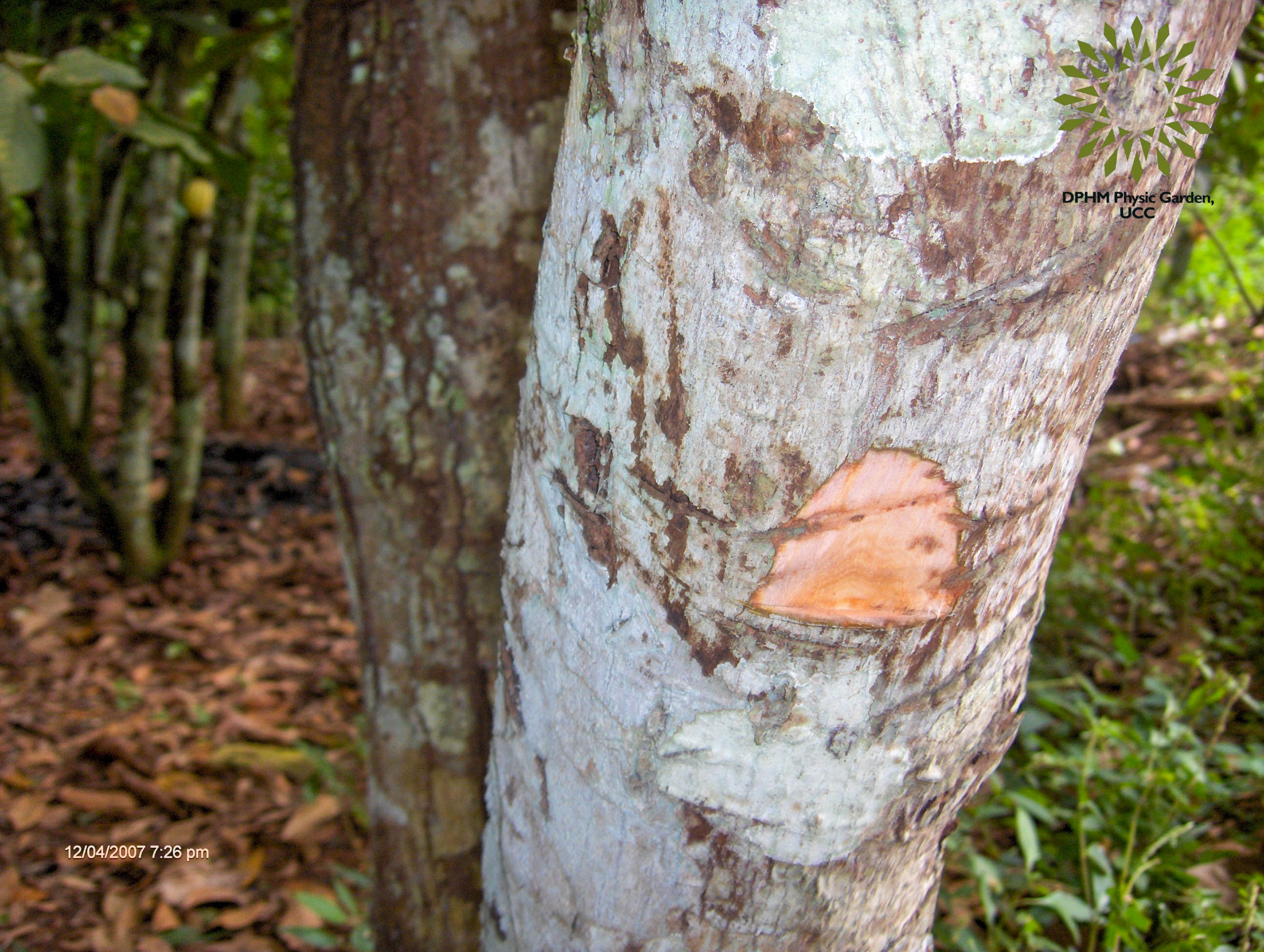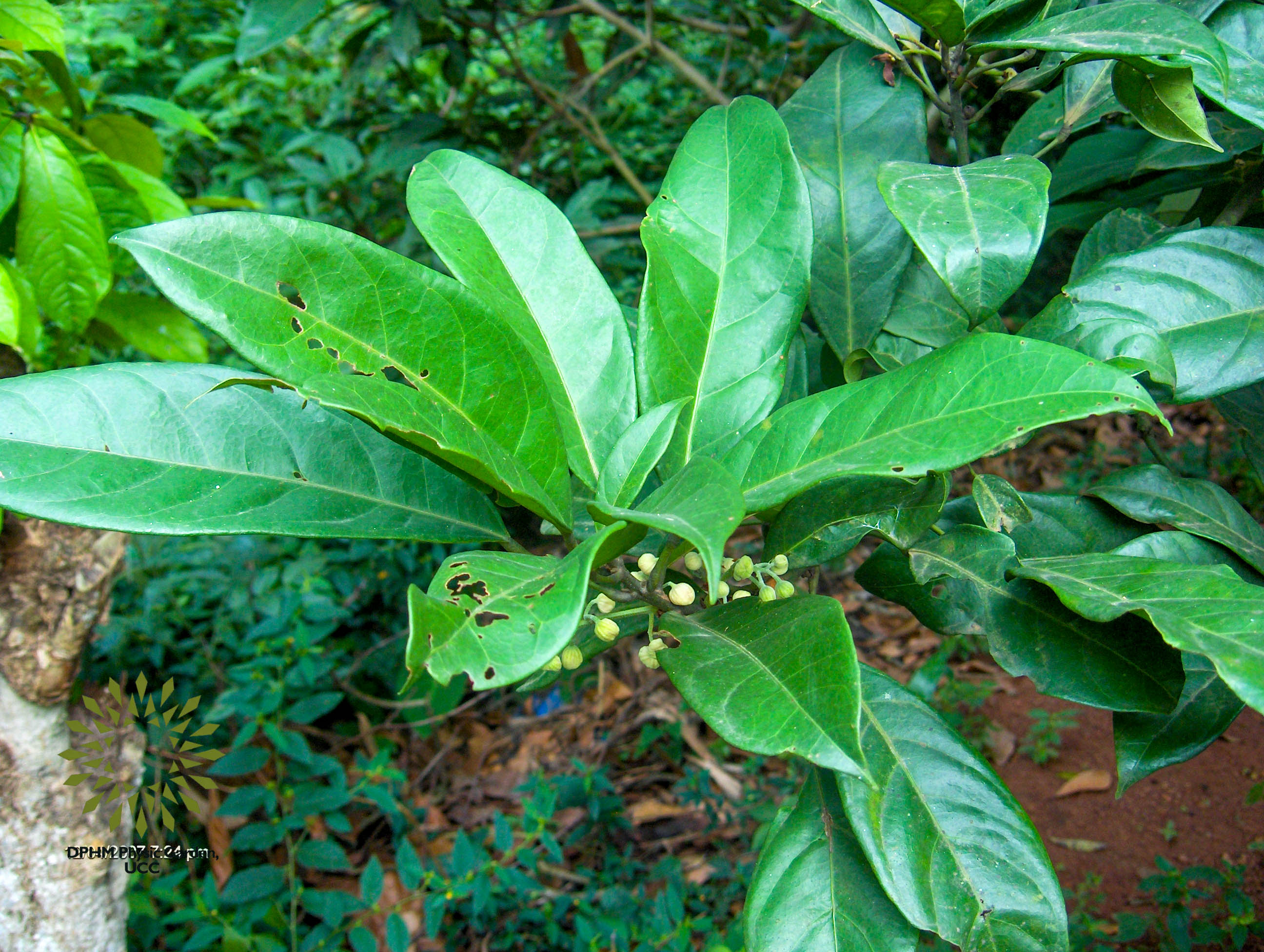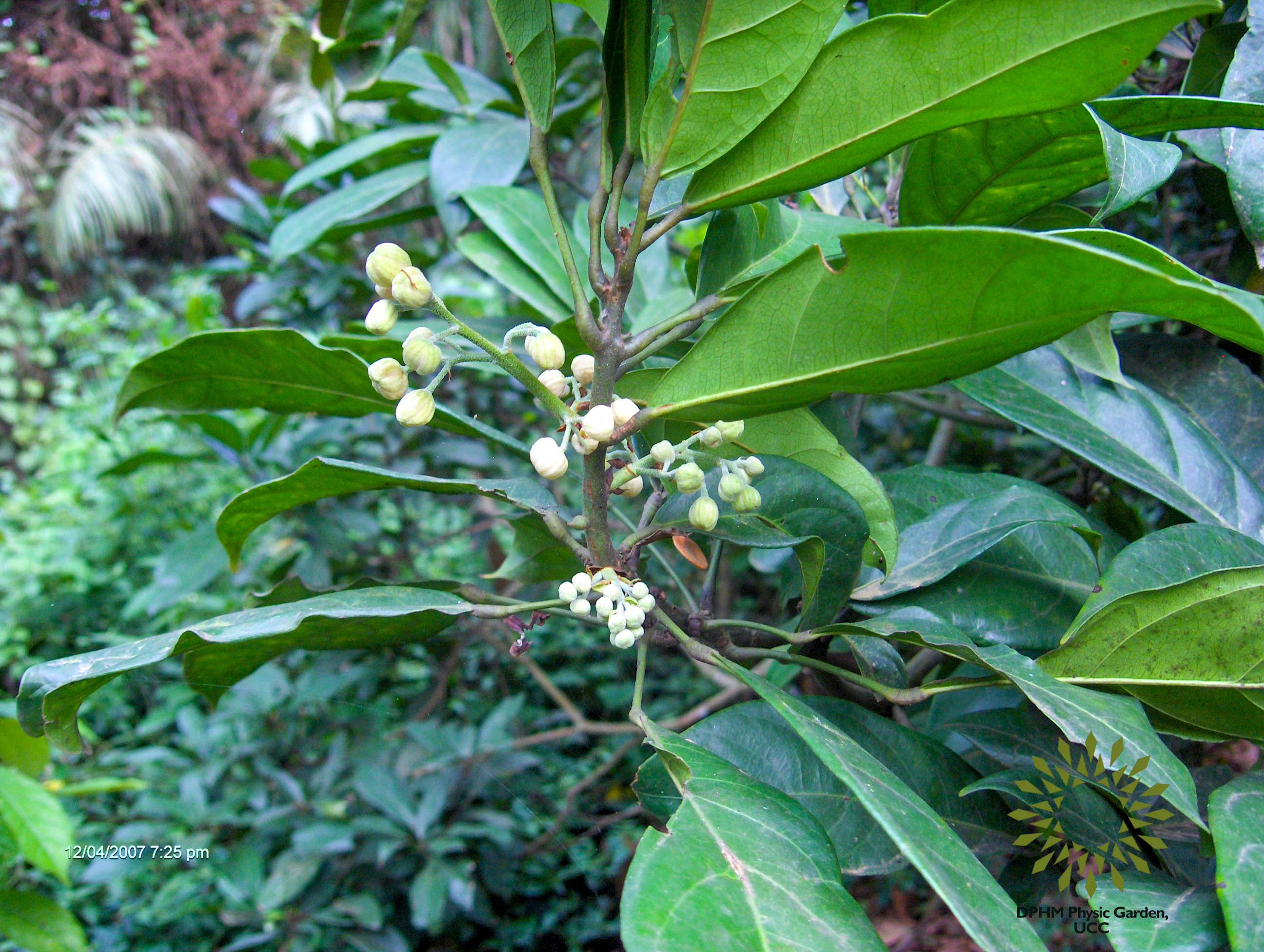CLASSIFICATION
Family: Malvaceae Genus: Cola
Species: C. nitida
COMMON NAMES
Kola nut, Cola, Kola, Bitter Kola, Gbanja kola (in English), Colatier (in French), Kolabaum (in German), Colatero (in Spanish).
LOCAL NAMES
Goro (in Fula and Hausa)
Akan: Kola nut, bese
Ewe: Kola
BOTANICAL DESCRIPTION
The kola nut tree typically grows between 9 to 12 meters tall but can reach up to 25 meters under optimal conditions. Its trunk can be up to 1.5 meters wide and may develop buttresses in older trees. The bark is thick, fibrous, and grey or brownish-grey with deep cracks, revealing pinkish-red inner wood when damaged. The leaves are simple, leathery, and alternately arranged, measuring 10 to 33 cm long and 5 to 13 cm wide with wavy edges. The flowers are clustered in panicles, with male flowers having a 2 wide calyx and female flowers having a 5 cm wide calyx with five carpels. The fruit consists of green, shiny follicles containing 4 to 10 seeds covered by a vitreous white arillus, which can be red, pink, or white. The seeds are egg-shaped or nearly round, measuring 3 to 3.5 cm long and 2 to 2.5 cm wide.
PHYTOCHEMICALS
Alkaloids contain Caffeine, Theophylline, Theobromine. Flavonoids also contain Catechin, Procyanidin B1, Procyanidin B2. Tannins, Saponins, Phenolics. Anthocyanins, flavonoids, glycosides, alkaloids, polyphenols, tanins, and saponosides are all present in C. nitida bark.
CHEMICAL STRUCTURE
PHARMACOLOGICAL ACTIVITY
DIURETIC ACTIVITY
Cola nitida, a plant with a methanolic extract, has been found to have kaliuretic, natriuretic, and diuretic effects without causing toxicity or electrolyte imbalance.
COGNITIVE AND NEUROLOGICAL BENEFITS
Alkaloids and caffeine in Cola nitida may help protect against neurodegenerative diseases and enhance cognitive function by inhibiting cholinesterase activity, potentially offering anti-Alzheimer's effects.
ANTIOXIDANT PROPERTIES
Cola nitida exhibits strong antioxidant activity by inhibiting lipid peroxidation and scavenging free radicals, which may help protect cells from oxidative damage and contribute to its potential benefits against various diseases.
ANTI-DIABETIC ACTIVITY
The plant has demonstrated potential in controlling blood sugar levels. It has been reported that Cola nitida seed extracts in hot water have anti-diabetic qualities, which may help treat type 2 diabetes.
CARDIOVASCULAR ACTIVITY
Cola nitida's stimulatory properties and capacity to improve blood circulation make it a potentially beneficial supplement for cardiovascular health. These plant's bioactive components may help to strengthen the heart and lower the risk factors for heart-related conditions.
ETHNOMEDICINAL/TRADITIONAL USES
Kola nuts serve multiple purposes, acting as a stimulant due to their caffeine content, which enhances energy and alertness. They are also used to aid digestion by increasing gastric secretion and hold cultural significance as symbols of friendship and goodwill in ceremonies. Furthermore, kola nuts are believed to function as an aphrodisiac, appetite suppressant, digestive aid, and pain reliever for headaches and migraines. They are also utilized in wound treatment, social interactions, traditional medicine for ailments like fever and dysentery, and for cleaning teeth with their bitter twigs.
TOXICOLOGICAL PROFILE
Cola nitida extracts are generally safe at moderate doses, but chronic use may have adverse effects. Caution is advised for individuals with hypertension, diabetes, or cardiovascular disease due to its caffeine content, and pregnant women should limit intake because of potential uterine stimulant effects.
DRUG-DRUG INTERACTION
A study in rabbits found that Cola nitida reduced the blood levels and duration of metoclopramide's presence in the body when given together. This suggests a potential herb-drug interaction, likely due to Cola nitida inducing metabolizing enzymes (CYP2D6, SULT2A1) and efflux transporters (P-glycoprotein), which accelerate metoclopramide's metabolism and elimination.
CLINICALLY VALIDATED USES
Cola nitida is clinically used for its stimulant effects to enhance cognitive function, as a diuretic to increase urine production without electrolyte imbalance, and for its anti-inflammatory and antimicrobial properties, making it beneficial in managing various health conditions.
REFERENCES
Abdala, S., Martín-Herrera, D., Benjumea, D., & Pérez-Paz, P. (2008). Diuretic activity of Smilax canariensis, an endemic Canary Island species. Journal of Ethnopharmacology, 119(1), 12–16. https://doi.org/10.1016/j.jep.2008.05.025
Abidoye, R. O., & Chijioke, A. P. (1990). Effect of kolanut (cola nitida vent) on the anthropometric measurement of newborn babies in Nigeria. Nutrition Research, 10(10), 1091–1098. https://doi.org/10.1016/S0271-5317(05)80331-8
Adedayo, L. D., Ojo, A. O., Awobajo, F. O., Adeboye, B. A., Adebisi, J. A., Bankole, T. J., Ayilara, G. O., Bamidele, O., Aitokhuehi, N. G., & Onasanwo, S. A. (2019). Methanol extract of Cola nitida ameliorates inflammation and nociception in experimental animals. Neurobiology of Pain, 5, 100027. https://doi.org/10.1016/j.ynpai.2019.100027
Adesanwo, J. K., Ogundele, S. B., Akinpelu, D. A., & McDonald, A. G. (2017). Chemical Analyses, Antimicrobial and Antioxidant Activities of Extracts from Cola nitida Seed. Journal of Exploratory Research in Pharmacology, 2(3), 67–77. https://doi.org/10.14218/JERP.2017.00015
Amadi, C. N., & Nwachukwu, W. I. (2020). The effects of oral administration of Cola nitida on the pharmacokinetic profile of metoclopramide in rabbits. BMC Pharmacology and Toxicology, 21(1), 4. https://doi.org/10.1186/s40360-019-0379-6
Dah-Nouvlessounon, D., Adoukonou-Sagbadja, H., Diarrassouba, N., Sina, H., Adjanohoun, A., Inoussa, M., Akakpo, D., Gbenou, J. D., Kotchoni, S. O., Dicko, M. H., & Baba-Moussa, L. (2015). Phytochemical Analysis and Biological Activities of Cola nitida Bark. Biochemistry Research International, 2015, 1–12. https://doi.org/10.1155/2015/493879
Dewole, E. A., Dewumi, D. F. A., Alabi, J. Y. T., & Adegoke, A. (2013). Proximate and Phytochemical of Cola nitida and Cola acuminata. Pakistan Journal of Biological Sciences, 16(22), 1593–1596. https://doi.org/10.3923/pjbs.2013.1593.1596
Erukainure, O. L., Sanni, O., Ijomone, O. M., Ibeji, C. U., Chukwuma, C. I., & Islam, M. S. (2019). The antidiabetic properties of the hot water extract of kola nut (Cola nitida (Vent.) Schott & Endl.) in type 2 diabetic rats. Journal of Ethnopharmacology, 242, 112033. https://doi.org/10.1016/j.jep.2019.112033
Mbembo, B. M., Inkoto, C. L., Amogu, J.-J. O., Ashande, C. M., Nagahuedi, J. M. S., Mpiana, P. T., & Ngbolua, K.-N. (2022). Mini-review on the phyto-chemistry, pharmacology and toxicology of Cola nitida (Vent.) Schott & Endl. (Malvaceae): A medically interesting bio-resource of multiple purposes in Africa. Natural Resources for Human Health, 2(3), 335–342. https://doi.org/10.53365/nrfhh/145511
Sanusi, K., Usman, U. Z., Usman, D., Adeshina, K. A., Uthman, Y. A., Jimoh, L., & Imam-Fulani, A. O. (2023). The Therapeutic Potential of Cola nitida in Health and Disease: A Narrative Review. https://doi.org/10.22541/au.169104269.99169022/v1



INFORMATION, DATA AND PICTURES ARE COPYRIGHT OF DPHM, SCHOOL OF PHARMACY, UCC.

